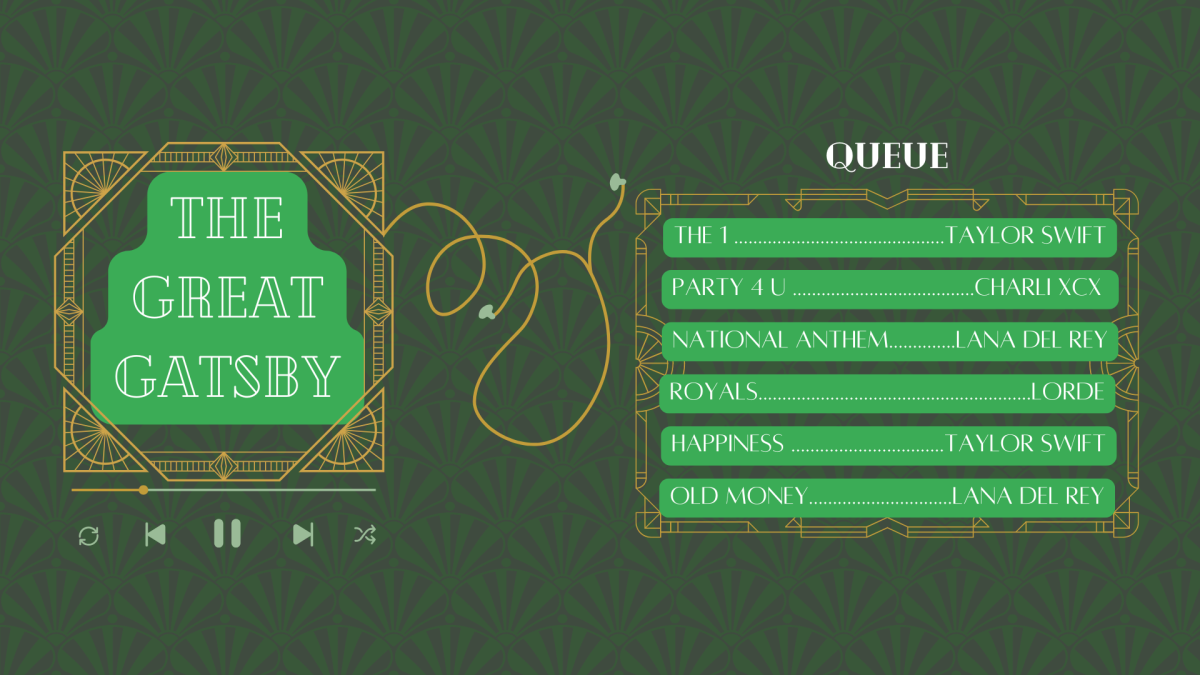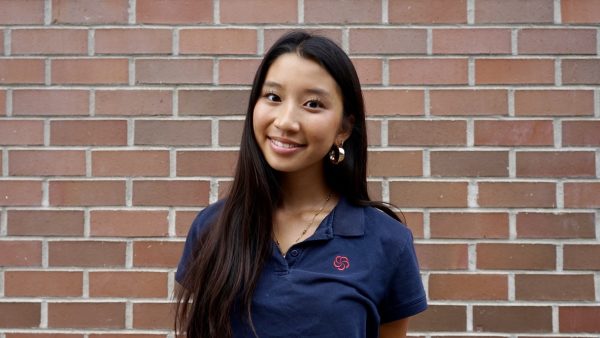As “The Great Gatsby” turns 100 years old this year, it’s having a comeback. More people are talking about it and analyzing its significance as a classic English class read, but what about its presence in music?
The juniors recently finished reading “Gatsby,” and as we went about our daily lives, we began noticing subtle references in the songs that we listened to. Some songs had direct connections while others were more discreet, but nonetheless, we generated a list of more than 40 songs that connected to the novel. While that is way too many songs to elaborate on, we narrowed it down to 13 songs where we see strong connections to “The Great Gatsby.”
*There are spoilers ahead, so do not read this if you plan on reading “The Great Gatsby” and want it to be a surprise.
the 1 (Taylor Swift)
The first direct connection in “the 1” is in the lyrics “roaring twenties, tossing pennies in the pool.” First of all, “Gatsby” is set in the 1920s, so while it is possible that Swift means “twenties” as in twenty years old, there is some ambivalence to the lyric, providing a slight nod to the novel. Additionally, when Swift sings “tossing pennies in the pool,” she alludes to the money and atmosphere of Gatsby and his parties. And, if you have read the book, you probably know that the pool is important, so by highlighting that in the lyrics, Swift adds another nod to the world of Gatsby. In the bridge of the song, Swift wonders, “if one thing had been different, / would everything be different today?” While there is no explicit connection in the lyrics to “Gatsby,” the song, which follows the afterthought of a relationship, brings up a question that many people ask about Gatsby and Daisy’s relationship: If Gatsby had true wealth, would Daisy choose him? After Daisy discovers that Gatsby does not come from wealth, she suddenly begins to distance herself from him, leading people to wonder if she would have stayed with Gatsby had it not been for that factor. Well, while we do not know what Swift is referring to when she asks “if one thing had been different,” given the previous references to “Gatsby” in the song and the recurring references to the novel throughout her discography, we see this line as another connection between “the 1” and “The Great Gatsby.”
party 4 u (Charli xcx)
Certainly, by now, most of us have seen at least one of the TikTok edits of “The Great Gatsby” and “Party 4 U,” but aside from the fabulous edits, the lyrics of the song contain connections to the novel. First of all, the song mentions “one thousand pink balloons,” and goes on to describe the many aspects of a party. While this could easily be any party, Charli xcx continually emphasizes the idea of extravagance, excess and indulgence that people often associate with Gatsby’s parties. Adding on to that, she sings, “Called your digits, but the phone kept ringin’,” which immediately brings our minds back to “Gatsby.” Anyone who has read the book can probably tell you that, like the pool, the phone acts as an important motif throughout the novel. Even though this reference is small and quick, we see it as a connection back to the world that Gatsby has created.
loml (Taylor Swift)
In this song, Swift uses countless literary devices, including allusions, metonymy and metaphors to convey the experience of a relationship. With all of these poetic devices, we do not find it to be a coincidence that we found so many allusions to “Gatsby.” The first connection we see is in the line “When your impressionist paintings of heaven turned out to be fakes / Well, you took me to hell too.” This line highlights the deception that the love interest created, as well as the impact on the narrator upon discovering that it was all fake. We believe this connects to the facade of money and power that Gatsby pretends to have. When Tom reveals to Daisy that Gatsby did not actually come from wealth, Daisy feels betrayed, a feeling which Swift perfectly conveys in “loml.” Later in the verse, Swift sings, “a con man sells a fool a get-love-quick scheme.” As Daisy famously states, the best thing a girl can be is “a beautiful little fool.” So, we see this line as another connection to “Gatsby,” and another instance in which Swift uses the themes and experiences of the characters from “The Great Gatsby” to convey her experiences. Finally, later on in the song, Swift sings that “something counterfeit is dead,” once again relating to the illusion of wealth that Gatsby created for Daisy.
Born to Die (Lana Del Rey)
From the moment the song begins, “Born To Die” captures the novel’s theme of chasing the unattainable. The tone of the song, which is dramatic with hints of sadness, parallels Gatsby’s desperate pursuits of a dream that ultimately leads to his downfall. The lyric “Don’t make me sad, don’t make me cry / Sometimes love is not enough and the road gets tough, I don’t know why” mirrors how Gatsby spends his whole life curating a version of himself so that Daisy will fall in love with him — but when he finally achieves his goal, he can’t understand why love can’t overcome the obstacles of the real world even when he thought it would. Another line, “I can see that once I was blind / I was so confused as a little child,” ties to the theme of the American Dream within “The Great Gatsby.” Like a child believing in a fairytale, James Gatz believes that working hard is the pathway to societal class and wealth. Lana Del Rey’s words illustrate the disillusionment that follows once Gatsby has seemingly achieved all of his goals and when his lifelong dream proves to be a facade. Through “Born To Die,” del Rey describes the thrill of reaching for a goal and the inevitable failure of the goal. The title itself mirrors the cursed nature of Gatsby’s journey.
National Anthem (Lana Del Rey)
It’s impossible not to include this song on the list due its explicit connections to the value of money, a prominent theme in “The Great Gatsby.” Lana Del Rey repeatedly sings, “money is the anthem of success.” This lyric embodies the values of many of the characters in “Gatsby,” specifically Daisy. Daisy’s relationships are often dictated by her understanding of the other person’s class. Additionally, in comparing money to the National Anthem, Del Rey speaks to the ways in which people swear by the power of money, presenting a critique similar to the one Fitzgerald presents in “The Great Gatsby.” Along with that connection, the bridge of the song provides a sense of indulgence and excess, something that goes hand in hand with Gatsby’s upper-class world.
Art Deco (Lana Del Rey)
At first listen, “Art Deco” may sound like the dreamy, detached portrayal of a party girl. But when thinking about its ties to “The Great Gatsby,” it has more similarities than differences. The title itself refers to the period of Art Deco, which flourished in the 1920s and 1930s — setting the song in the exact era of Gatsby’s world, when the luxurious Art Deco style symbolized wealth and excess. The lyric “You’re so Art Deco, out on the floor / Shining like gunmetal, cold and unsure” represents Gatsby’s emotionally detached party guests. The parties, on the outside, are beautiful, but underneath, they are lonely and performative as the guests leave and Gatsby is left alone to deal with the mess. Lana del Rey also repeats “You’re so Art Deco / Baby, you’re so ghetto” throughout the song. This mirrors the tension in “The Great Gatsby” between high society and street culture. Gatsby embodies the flashy “new money” style while Tom and Daisy symbolize the authentic high class. Gatsby, despite all his wealth, will never be old money, and he’s performing a role he can’t fully take on. Del Rey also sings, “You’re looking second rate,” adding on to the idea that Gatsby can never fit in with the upper class just by fabricating an identity based on wealth and appearance alone. In the novel, Fitzgerald writes about how the parties become less lively and how fewer people come as Gatsby’s dream fades out. As the song fades out, too, the listener is left with a feeling of loneliness and hollowness. “Art Deco” captures how, once the 1920 setting’s thin layer of glamour, luxury, and allure is stripped away, all that is left is decay.
Getaway Car (Taylor Swift)
“Getaway Car” evokes the sense of freedom, exhilaration and illicitness present throughout the book. The song details a clandestine affair between two people, much like the many affairs in “Gatsby.” The song connects more directly to the novel with the car. Swift repeatedly sings, “we were drivin’ the getaway car / we were flyin’ but we’d never get far,” specifically painting the notorious scene of Daisy and Gatsby driving in Gatsby’s car. Cars act as a major symbol throughout the novel, so even while Swift may not have written the song directly in the context of “The Great Gatsby,” the overall tone and themes of the song connect to those of the novel.
This Is Why We Can’t Have Nice Things (Taylor Swift)
“This is why we can’t have nice things” contains the most direct reference to “The Great Gatsby” out of all of the songs on this list; Swift sings, “Feelin’ so Gatsby for that whole year.” Along with this explicit reference, Swift describes Gatsby’s illustrious life, singing, “it was so nice throwin’ big parties / jump into the pool from the balcony / everyone swimmin’ in a champagne sea.” All of these lyrics paint the exact image of Gatsby’s extravagant parties. Swift goes on to change the tone of the song, commenting on the dangers of the distraction that living that luxurious life involves, presenting a similar argument to Fitzgerald’s in “The Great Gatsby.”
New Romantics (Taylor Swift)
The song “New Romantics” is about the idea of being young and new to the world. The upbeat tone of the song insinuates the extravagance of Gatsby’s life and helps form a world similar to the world of “The Great Gatsby.” Swift sings “we show off our different scarlet letters,” hinting at the possible unlawful actions of the people in the song, which connects to the illegal manner in which some of the characters in “Gatsby” obtained their money. However, what’s interesting about this song is that rather than emphasizing the glory of upper-class life, I believe Swift speaks to the power of middle and lower-class life. Swift sings, “we wait for trains that just aren’t coming,” which drew my attention to the Valley of Ashes, where people watch the trains passing by, waiting for the one that will take them to a better place. Additionally, Swift repeatedly states, “the best people in life are free.” In this lyric, Swift deemphasizes the value of money, claiming that money can’t buy happiness. This is opposite to Daisy’s viewpoint in the text, where all of her relationships revolve around money. On the whole, with this song, Swift presents a critique of the ways in which people associate money with value, a theme common throughout “Gatsby.”
Royals (Lorde)
While “The Great Gatsby”’s characters chase wealth and success, “Royals” by Lorde criticizes the things that characters such as Gatsby, Tom and Daisy hold sacred. Right from the start of the song, Lorde’s lyrics about “driving Cadillacs in our dreams” evoke Gatsby’s yellow Rolls-Royce that he prizes so proudly. The car is a major symbol of his desire to impress Daisy. Throughout the song, Lorde names symbols of wealth: “Cristal, Maybach, diamonds on your timepiece,” following those lines with “That kind of luxe just ain’t for us.” In “The Great Gatsby,” every major character holds the belief that wealth equals success. Gatsby recreates his entire identity around wealth to fit into Daisy’s world. Meanwhile, Lorde speaks negatively on the endless ambition for money, saying that happiness doesn’t depend on social class or material wealth. In this way, “Royals” acts as a direct critique of the ideas in “The Great Gatsby.” One of the most striking lyrics is: “We’ll never be royals / It don’t run in our blood.” This connects to Gatsby’s belief that he can manufacture an identity that will blend him seamlessly into the upper class. Lorde acknowledges what Gatsby is afraid to accept: class is rigidly defined by birth, and cannot be changed by ambition, unlike what the American Dream promises.
Old Money (Lana Del Rey)
In “Old Money,” Del Rey uses a slow and somber tone to complement the lyrics, which speak of money and luxury. In itself, the contrast between the lyrics and the melody of the song creates a song that feels very reminiscent of “The Great Gatsby.” On the outside, Gatsby has a very luxurious, carefree life, which the lyrics, “Blue hydrangea, cold cash divine / Cashmere, cologne, and white sunshine” speak to. However, the sadness with which Del Rey sings these lyrics evokes a sense of longing, perhaps for the upper-class life she describes. Furthermore, throughout the song, Del Rey demonstrates her attraction to these characteristics by repeating, “And if you call for me, you know I’ll run / I’ll run to you, I’ll run to you.” These lyrics, along with the other ones in these verses, represent her dedication and constant pursuit of someone who represents the upper-class world, similar to Gatsby’s pursuit of wealth and status. Additionally, the line, “Red racing cars,” presents another similarity to “The Great Gatsby,” where cars serve as an important motif throughout the novel. Finally, it’s impossible not to mention the title, “Old Money,” when examining the connections between this song and “Gatsby.” In the novel, both Gatsby and Tom are in possession of great wealth; however, neither of them has or will ever obtain the status that comes with having old money, and their inability to achieve that status influences their actions throughout the novel. In titling this song “Old Money,” Del Rey emphasizes the inability to fully obtain the wealth and status that captivates so many people.
illicit affairs (Taylor Swift)
Due to the multiple affairs between characters in “The Great Gatsby,” the song titled “Illicit affairs” inherently possesses a subtle connection to the novel. Along with that, two lines stand out as possible connections to the book. First, Swift sings, “They show their truth one single time / but they lie and they lie and they lie / a million little times.” While these lyrics do not directly reference something in the novel, they evoke the sense of deception and falsity that make up Gatsby’s character. Later on in the song, Swift makes a more direct reference, singing “look at this idiotic fool that you made me.” This line connects back to Daisy’s famous line; however, instead of embracing the idea of being a “beautiful fool,” Swift is enraged at the ease with which she fell into the expectation. With this line, she presents a slight critique of the ideal that Daisy describes, and she insinuates that she would rather be like Daisy: aware of the real world.
happiness (Taylor Swift)
Happiness is full of references to “The Great Gatsby.” While we do not believe the song is a direct retelling of “The Great Gatsby,” we believe that Swift uses the novel as a metaphor for her own experiences. In the song, Swift sings, “I hope she’ll be a beautiful fool, who takes my spot next to you.” This is a direct reference to one of Daisy’s most famous lines, “I hope she’ll be a fool. That’s the best thing a girl can be in this world, a beautiful little fool.” With this line, Swift puts herself into Daisy’s character, speaking to her position in her relationship. Along with this fairly obvious reference, Swift sings, “all you want from me now is the green light of forgiveness.” The green light is one of the most famous motifs in “The Great Gatsby,” so this reference further reinforces that Swift is using aspects of “Gatsby” to convey her experience. In addition to those references, Swift continually mentions that there is happiness “across our great divide,” which could be a reference to both the physical divide between Daisy and Gatsby in East and West Egg, or it could refer to the class divide between the two characters. Nonetheless, “Happiness” is yet another song in Swift’s discography that is full of references to “The Great Gatsby” and which uses the themes and characters of the novel to represent her personal experiences.
The prevalence of the novel throughout these thirteen (plus) songs demonstrates just how deeply “The Great Gatsby” continues to influence our lives, even a century after its publication.




